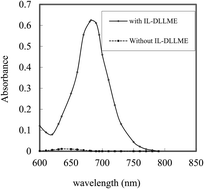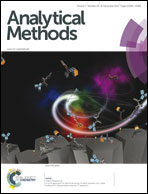An ionic liquid-based microextraction method for highly selective and sensitive trace determination of nickel in environmental and biological samples
Abstract
A simple and rapid dispersive liquid–liquid microextraction procedure (IL-DLLME) based on an ionic liquid was developed for the selective determination of nickel with spectrophotometric detection. Nickel was initially complexed with 5-(2-benzothiazolylazo)-8-hydroxyquinolene [BTAHQ] reagent at pH 4.0. The IL-DLLME procedure was then performed by using a few microliters of the room temperature ionic liquid (RTIL) 1-hexyl-3-methylimidazolium hexafluorophosphate [C6mim][PF6] as the extractant while methanol was the disperser solvent. After the microextraction procedure, the Ni-enriched RTIL phase was solubilized in methanol and the absorbance at λmax 682 was directly measured against a reagent blank similarly prepared. The effect of several variables on Ni–BTAHQ complex formation, extraction with the dispersed RTIL phase, and analyte detection with spectrophotometry was carefully studied. An enrichment factor of 200 was obtained with only 10 mL of sample solution and under optimal experimental conditions. The resultant limit of detection (LOD) was 9.8 ng L−1, while the relative standard deviation (RSD) was 1.47% (at 1.0 μg L−1 Ni level and n = 10). The accuracy of the proposed method was tested by analysis of a certified reference material. The method was successfully applied for the determination of nickel in environmental standard reference materials and biological samples.


 Please wait while we load your content...
Please wait while we load your content...